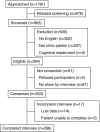Primary care validation of a single-question alcohol screening test
- PMID: 19247718
- PMCID: PMC2695521
- DOI: 10.1007/s11606-009-0928-6
Primary care validation of a single-question alcohol screening test
Erratum in
- J Gen Intern Med. 2010 Apr;25(4):375
Abstract
Background: Unhealthy alcohol use is prevalent but under-diagnosed in primary care settings.
Objective: To validate, in primary care, a single-item screening test for unhealthy alcohol use recommended by the National Institute on Alcohol Abuse and Alcoholism (NIAAA).
Design: Cross-sectional study.
Participants: Adult English-speaking patients recruited from primary care waiting rooms.
Measurements: Participants were asked the single screening question, “How many times in the past year have you had X or more drinks in a day?”, where X is 5 for men and 4 for women, and a response of 1 or greater [corrected] is considered positive. Unhealthy alcohol use was defined as the presence of an alcohol use disorder, as determined by a standardized diagnostic interview, or risky consumption, as determined using a validated 30-day calendar method.
Main results: Of 394 eligible primary care patients, 286 (73%) completed the interview. The single-question screen was 81.8% sensitive (95% confidence interval (CI) 72.5% to 88.5%) and 79.3% specific (95% CI 73.1% to 84.4%) for the detection of unhealthy alcohol use. It was slightly more sensitive (87.9%, 95% CI 72.7% to 95.2%) but was less specific (66.8%, 95% CI 60.8% to 72.3%) for the detection of a current alcohol use disorder. Test characteristics were similar to that of a commonly used three-item screen, and were affected very little by subject demographic characteristics.
Conclusions: The single screening question recommended by the NIAAA accurately identified unhealthy alcohol use in this sample of primary care patients. These findings support the use of this brief screen in primary care.
Comment in
-
Brief approaches to alcohol screening: practical alternatives for primary care.J Gen Intern Med. 2009 Jul;24(7):881-3. doi: 10.1007/s11606-009-1014-9. J Gen Intern Med. 2009. PMID: 19495888 Free PMC article. No abstract available.
Similar articles
-
Use of a single alcohol screening question to identify other drug use.Drug Alcohol Depend. 2014 Jun 1;139:178-80. doi: 10.1016/j.drugalcdep.2014.03.027. Epub 2014 Apr 5. Drug Alcohol Depend. 2014. PMID: 24768061 Free PMC article.
-
Use of the screening suggested by the National Institute on Alcohol Abuse and Alcoholism and of a newly derived tool for the detection of unhealthy alcohol drinkers among surgical patients.J Stud Alcohol Drugs. 2012 Jan;73(1):126-33. doi: 10.15288/jsad.2012.73.126. J Stud Alcohol Drugs. 2012. PMID: 22152670
-
A single-question screening test for drug use in primary care.Arch Intern Med. 2010 Jul 12;170(13):1155-60. doi: 10.1001/archinternmed.2010.140. Arch Intern Med. 2010. PMID: 20625025 Free PMC article.
-
Screening and brief intervention for alcohol and other abuse.Adolesc Med State Art Rev. 2014 Apr;25(1):126-56. Adolesc Med State Art Rev. 2014. PMID: 25022191 Review.
-
Screening for Unhealthy Alcohol and Drug Use in General Medicine Settings.Med Clin North Am. 2022 Jan;106(1):13-28. doi: 10.1016/j.mcna.2021.08.002. Med Clin North Am. 2022. PMID: 34823726 Review.
Cited by
-
Screening and brief intervention for substance misuse: Does it reduce aggression and HIV-related risk behaviours?Alcohol Alcohol. 2015 May;50(3):302-9. doi: 10.1093/alcalc/agv007. Epub 2015 Mar 1. Alcohol Alcohol. 2015. PMID: 25731180 Free PMC article. Clinical Trial.
-
Associations Between Different Types of Housing Insecurity and Future Emergency Department Use Among a Cohort of Emergency Department Patients.J Health Care Poor Underserved. 2023;34(3):910-930. J Health Care Poor Underserved. 2023. PMID: 38015129 Free PMC article.
-
Management of Mental Health Disorders, Substance Use Disorders, and Suicide in Adults with Spinal Cord Injury: Clinical Practice Guideline for Healthcare Providers.Top Spinal Cord Inj Rehabil. 2021 Spring;27(2):152-224. doi: 10.46292/sci2702-152. Top Spinal Cord Inj Rehabil. 2021. PMID: 34108836 Free PMC article. No abstract available.
-
Addressing alcohol use in HIV-infected persons.Top Antivir Med. 2011 Nov;19(4):143-7. Top Antivir Med. 2011. PMID: 22156216 Free PMC article. Review.
-
The Reciprocal Association between Problem Gambling and Mental Health Symptoms/Substance Use: Cross-Lagged Path Modelling of Longitudinal Cohort Data.J Clin Med. 2019 Nov 6;8(11):1888. doi: 10.3390/jcm8111888. J Clin Med. 2019. PMID: 31698740 Free PMC article.
References
-
- Whitlock EP, Polen MR, Green CA, Orleans T, Klein J. Behavioral counseling interventions in primary care to reduce risky/harmful alcohol use by adults: a summary of the evidence for the U.S. preventive services task force. Ann Intern Med. 2004;140:557–568. - PubMed
-
- United States Preventive Services Task Force Screening and behavioral counseling interventions in primary care to reduce alcohol misuse: recommendation statement. Ann Intern Med. 2004;140:554–556. - PubMed
-
- Mayfield D, McLeod G, Hall P. The CAGE questionnaire: validation of a new alcoholism screening instrument. Am J Psychiatry. 1974;131:1121–1123. - PubMed
-
- Bohn MJ, Babor TF, Kranzler HR. The Alcohol Use Disorders Identification Test (AUDIT): validation of a screening instrument for use in medical settings. J Stud Alcohol. 1995;56:423–432. - PubMed
Publication types
MeSH terms
Grants and funding
LinkOut - more resources
Full Text Sources
Medical
Miscellaneous


